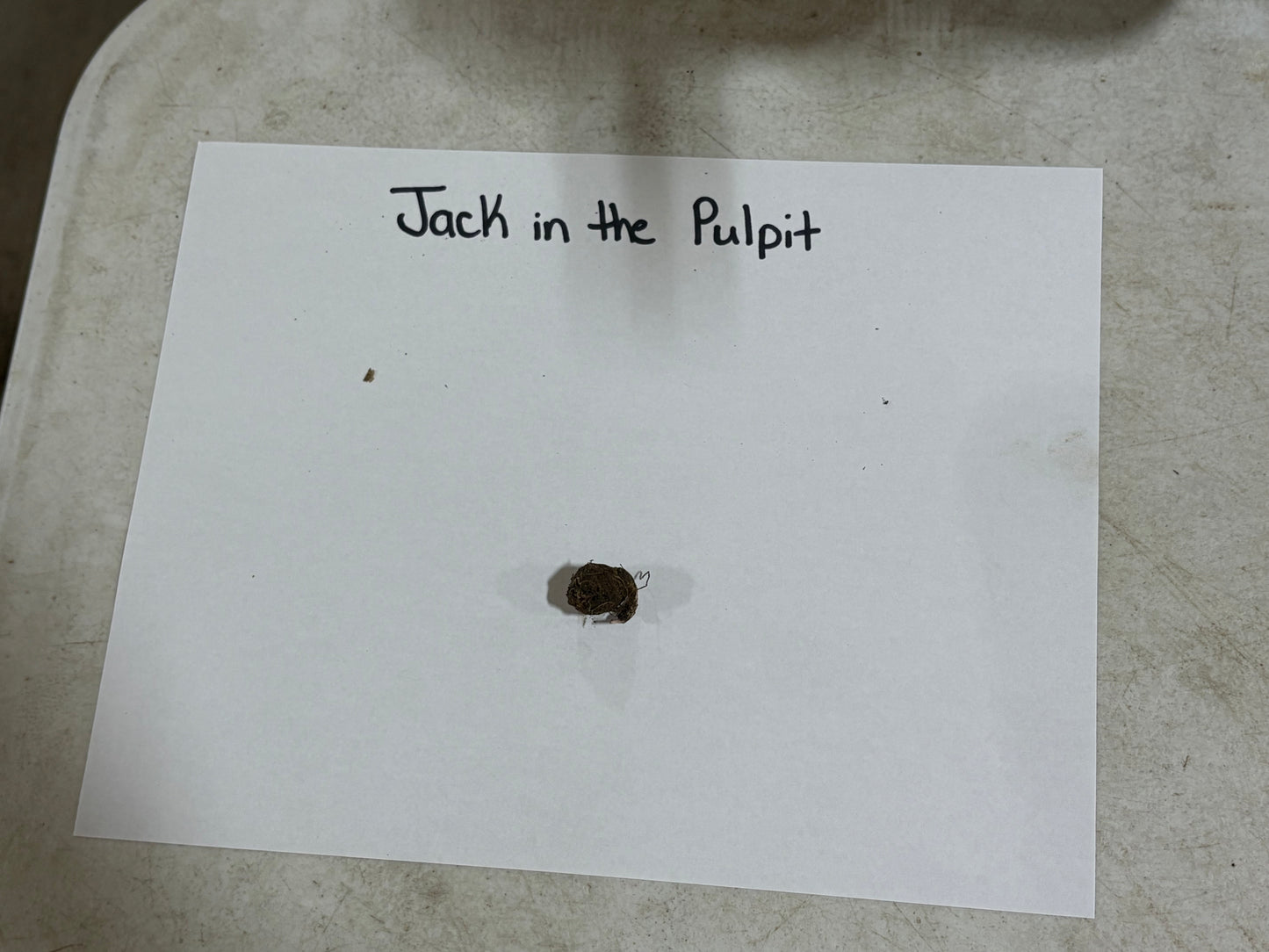Couldn't load pickup availability
🌸When you add 1 plant to cart, it automatically adds the free one
Jack in the Pulpit | Arisaema triphyllum
Jack in the Pulpit (Arisaema triphyllum) is an herbaceous perennial with unexpected, vase-like flowers and unique leaves.
Plant Details - Jack in the Pulpit Plants
Family: Araceae
Light Requirement: Full to Partial Shade
Water Needs: Moist
Height: 1 – 2 ft.
Spread: 12 – 18 in.
Growth Rate: Fast
Bloom Time: Spring
Flower Color: Green
Wildlife Value: Attracts bees
Landscape Uses and Maintenance for Jack in the Pulpit Plants
Jack in the Pulpit is one of many perfect plants for a shady spot in your garden. Flowers are green and have distinctive stripes of dark purple. Add a unique touch to any garden bed with this plant that will make you wonder if there are fairies living somewhere near it.
The flowers bloom in the spring and will then give way to a stalk of red berries that will mesmerize you, your family.
Perfect for your shade garden, woodland garden, or as a rare choice for the cottage garden. Pair with Mayapple, Wild Ginger, Bleeding Heart, and ferns to enjoy a serene woodland garden.
This plant needs plenty of shade, so plant it in full to partial shade. Avoid planting in the sun; it will get sun scald and discoloration.
Give it a location in your garden with moist to wet but well draining soil. This is an ancient-looking plant that is naturally found in locations such as forests, marshes, swamps, and woodlands. Avoid planting in heavy clay soils.
This is a low maintenance plant that needs little care during the growing season. Only water this plant in the event of drought. Add humus or other organic matter to the soil in order to mimic the rich forest floor environment.
Once the seeds have matured and have fully turned a bright red, they are able to be harvested from the plant and then sown in the soil immediately.
This is a deer-resistant plant. Pest and pathogen resistant, too.
Noteworthy Characteristics of Jack in the Pulpit Plants
Jack in the Pulpit will attract plenty of pollinators to your garden. The flowers are pollinated by fungus gnats.
The berries will attract birds including Wood Thrush and wild pheasants to your garden.
This Is How Your Plants Will Look upon Delivery

Bloom Season
Spring
Bloom/Foliage Color
Purple
Height at Maturity
Under 12"
Care
Jack in the Pulpit prefers rich, moist soil. Frequent watering keeps the soil damp. Lay mulch near the base to maintain moisture and protect roots. Use a balanced, slow-release fertilizer and avoid over-fertilizing. Protect from extreme heat.
Plant Reproduction
Jack In The Pulpit spreads and colonizes through both sexual and asexual reproduction.
How to Grow and Care for Bare Root Perennials, Tubers, and Bulbs
Bare root perennials, tubers, and bulbs are an easy and economical way to jumpstart your garden with lasting beauty. These dormant plants should be planted in early spring or fall while the soil is cool and workable. Before planting, soak bare roots in water for 1–2 hours to rehydrate them. Choose a location based on the plant’s light needs—most flowering types prefer full sun, while others thrive in partial shade.
For bare root perennials, dig a shallow hole and spread the roots out naturally, ensuring the crown is level with the soil surface. For tubers and bulbs, plant with the pointed side facing up at a depth about two to three times their height. Cover with soil, gently press down, and water thoroughly.
Keep soil consistently moist (not soggy) until new growth appears. Add mulch to retain moisture and suppress weeds, but avoid covering the crown or bulb tops. Once established, these plants require little maintenance—just seasonal watering, occasional dividing, and deadheading or pruning as needed. With proper care, they’ll return and thrive year after year.
Shipping date depends on the date displayed and chosen when you order from the product's page.
We only accept returns on plants verified dead. If you think your plants have died, we offer a 1 year warranty, please use use this File a Claim Link to verify dead plants and start with return warranty process.





Caring Tips
How do I care for my Jack In The Pulpit?
Each box contains detailed care instructions and information about your product. But here's the basics.
Care Tips
Jack in the Pulpit prefers rich, moist soil. Frequent watering keeps the soil damp. Lay mulch near the base to maintain moisture and protect roots. Use a balanced, slow-release fertilizer and avoid over-fertilizing. Protect from extreme heat.
Light Requirements
Jack in the Pulpit (Arisaema triphyllum) thrives in dappled or filtered sunlight. It prefers shady woodland conditions with indirect light, mimicking its natural forest habitat. Ensure it receives protection from direct sun to maintain its vibrant foliage and unique blooms.
Hardy Planting Zones
4 • 5 • 6 • 7 • 8 • 9
I initially planted a couple, and now they’ve spread via cormlets into a lovely little patch that pops up each spring without extra fuss.
I adore how native this plant is to eastern woodlands, yet it looks exotic. The striped spathe arching over the spadix is unbelievably distinct.
Planted in autumn-from-corm, this gem has thrived in the shadiest corner of my yard. Only annual mulch, and it flourishes—so resilient.
Not only is it sculptural, but it really draws gnats and small flies—nature’s little visitors, trapped then released—very cool to observe.
The tubular stalk with its 3-leaflet leaves and mysterious inflorescence gives off a lush, tropical vibe—even though it’s truly a spring woodland native.






